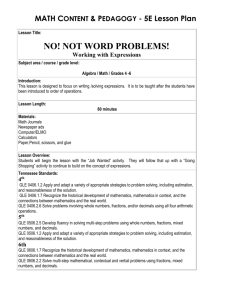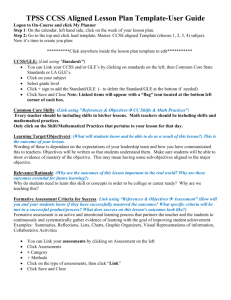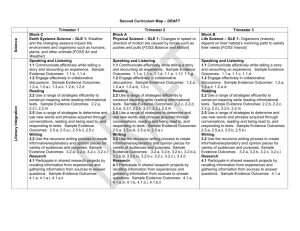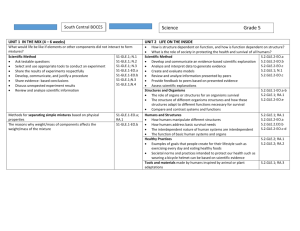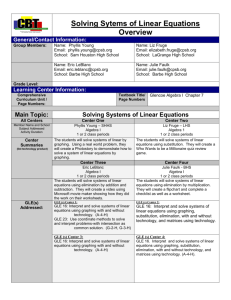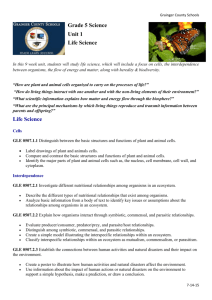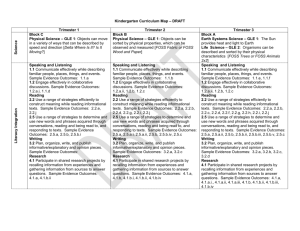(0-1.9 GLE) Massachusetts ABE Reading Standards and Benchmarks
advertisement
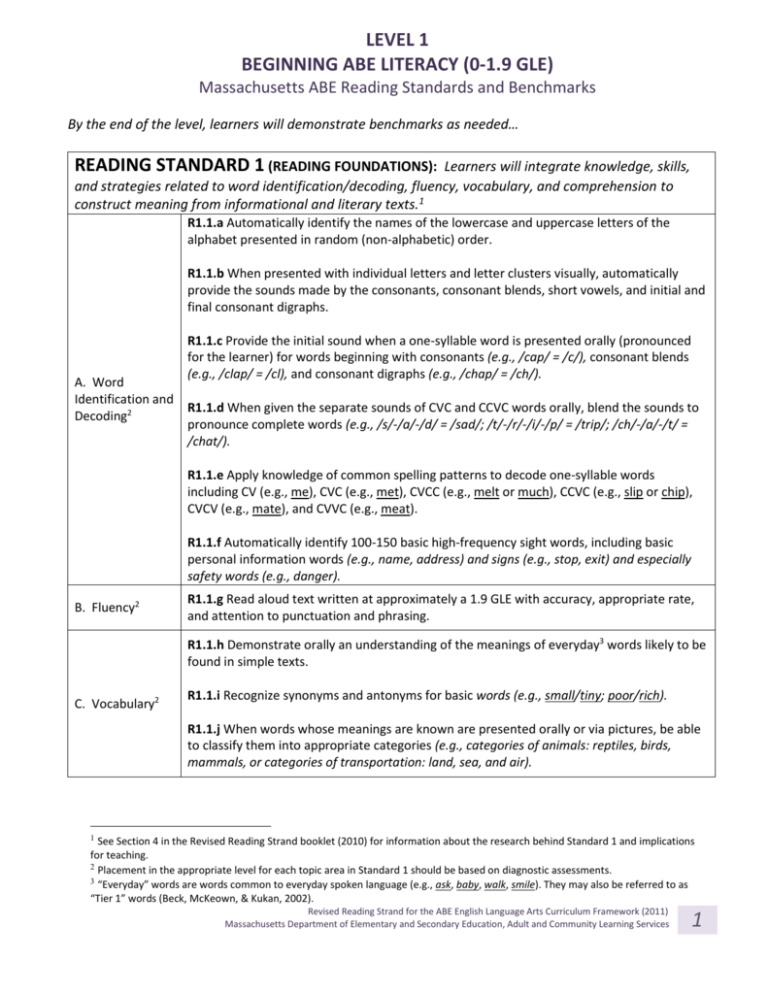
LEVEL 1 BEGINNING ABE LITERACY (0-1.9 GLE) Massachusetts ABE Reading Standards and Benchmarks By the end of the level, learners will demonstrate benchmarks as needed… READING STANDARD 1 (READING FOUNDATIONS): Learners will integrate knowledge, skills, and strategies related to word identification/decoding, fluency, vocabulary, and comprehension to construct meaning from informational and literary texts.1 R1.1.a Automatically identify the names of the lowercase and uppercase letters of the alphabet presented in random (non-alphabetic) order. R1.1.b When presented with individual letters and letter clusters visually, automatically provide the sounds made by the consonants, consonant blends, short vowels, and initial and final consonant digraphs. R1.1.c Provide the initial sound when a one-syllable word is presented orally (pronounced for the learner) for words beginning with consonants (e.g., /cap/ = /c/), consonant blends (e.g., /clap/ = /cl), and consonant digraphs (e.g., /chap/ = /ch/). A. Word Identification and R1.1.d When given the separate sounds of CVC and CCVC words orally, blend the sounds to Decoding2 pronounce complete words (e.g., /s/-/a/-/d/ = /sad/; /t/-/r/-/i/-/p/ = /trip/; /ch/-/a/-/t/ = /chat/). R1.1.e Apply knowledge of common spelling patterns to decode one-syllable words including CV (e.g., me), CVC (e.g., met), CVCC (e.g., melt or much), CCVC (e.g., slip or chip), CVCV (e.g., mate), and CVVC (e.g., meat). R1.1.f Automatically identify 100-150 basic high-frequency sight words, including basic personal information words (e.g., name, address) and signs (e.g., stop, exit) and especially safety words (e.g., danger). B. Fluency2 R1.1.g Read aloud text written at approximately a 1.9 GLE with accuracy, appropriate rate, and attention to punctuation and phrasing. R1.1.h Demonstrate orally an understanding of the meanings of everyday3 words likely to be found in simple texts. C. Vocabulary2 R1.1.i Recognize synonyms and antonyms for basic words (e.g., small/tiny; poor/rich). R1.1.j When words whose meanings are known are presented orally or via pictures, be able to classify them into appropriate categories (e.g., categories of animals: reptiles, birds, mammals, or categories of transportation: land, sea, and air). 1 See Section 4 in the Revised Reading Strand booklet (2010) for information about the research behind Standard 1 and implications for teaching. 2 Placement in the appropriate level for each topic area in Standard 1 should be based on diagnostic assessments. 3 “Everyday” words are words common to everyday spoken language (e.g., ask, baby, walk, smile). They may also be referred to as “Tier 1” words (Beck, McKeown, & Kukan, 2002). Revised Reading Strand for the ABE English Language Arts Curriculum Framework (2011) Massachusetts Department of Elementary and Secondary Education, Adult and Community Learning Services 1 LEVEL 1 BEGINNING ABE LITERACY (0-1.9 GLE) Massachusetts ABE Reading Standards and Benchmarks R1.1.k Identify and understand uses of the conventions of written language (e.g., how to hold a book, that print goes from left to right, visual markers of a sentence such as starts with a capital letter, ends with a final punctuation mark; the punctuation symbols such as period, question mark, exclamation point, quotation marks and their uses; the title of an article, book, or chapter; the function of captions and sub-heads and the relationship of pictures and other visuals to nearby text). D. Comprehension Strategies2 R1.1.l Use pre-reading strategies to determine or refine the purpose for reading (*identify type of text, purpose and intended audience; preview title/headings/ visuals; ask self, “What is it about? What do I know about this? What do I want to know?”; make predictions). R1.1.m Use strategies to monitor and/or enhance comprehension4 (*know what to do when encountering a word one cannot decode or whose meaning is not known; paraphrase short sections, both read below GLE 2 and presented orally above GLE 2; scan for important words and numbers; make/check predictions). READING STANDARD 2 (INFORMATIONAL READING): Learners will comprehend, analyze, and critique informational expository, persuasive, procedural, and functional texts—for a variety of academic and non-academic purposes. texts5—including R2.1.a Identify common ways of presenting information using print and its purposes (e.g., signs, lists, product labels, forms, directions, and expository text). A. Author’s Organization and Purpose B. Locating and Using Information and Ideas R2.1.b Identify the main idea from a group of words or conceptually related pictures (e. g., worm, fishing pole, lake = “fishing”). R2.1.c Identify the topics and stated main ideas of short passages or paragraphs (both read below GLE 2 and presented orally above GLE 2). R2.1.d Locate explicitly stated information in brief nonfiction texts and other print materials below GLE 2 (e.g., the place on a form where one’s signature is required; basic food names on supermarket aisle signs). R2.1.e Make simple inferences and draw basic conclusions based on information presented in text written below GLE 2 (e.g., from product labels determine which item costs more, or from a highway sign with mileage to multiple destinations determine which is further, Boston or Fall River?). * Items preceded by an asterisk provide further clarification about what should be taught/learned to prepare students to reach the benchmark. 4 These strategies are listed to illustrate options, not to imply that all or even most of them should be taught at each level. 5 Informational texts are divided into four categories. Text types commonly (but not exclusively) associated with each are listed: expository texts: informational books; information-based magazine, newspaper, or Internet articles; brochures and pamphlets; tables; charts; graphs; biographies and autobiographies (when used primarily to learn details of a person’s life); persuasive texts: editorials; letters to the editor; political cartoons; essays; speeches; ads; book/movie/product reviews; procedural texts: manuals; directions; operating instructions; functional texts: forms; work orders; applications; maps; signs; schedules; menus; invitations; posters; classified ads; labels; catalogs; legal agreements; e-mails; letters; memos. Revised Reading Strand for the ABE English Language Arts Curriculum Framework (2011) Massachusetts Department of Elementary and Secondary Education, Adult and Community Learning Services 2 LEVEL 1 BEGINNING ABE LITERACY (0-1.9 GLE) Massachusetts ABE Reading Standards and Benchmarks C. Reliability and Completeness of Information D. Synthesis of Ideas R2.1.f Identify and interpret pictures used by the author to influence the reader’s opinions and actions (e.g., pictures used in ads). R2.1.g Evaluate the overall reliability or completeness of information provided in texts that are above GLE 2 and presented orally (e.g., about a health issue, a TV show, a sale at a store) as to whether the information is complete enough to inform one’s decisions. R2.1.h Identify similarities and differences in the information presented in two brief texts written above GLE 2 on the same topic and which is presented orally (e.g., two reviews of a movie or TV show; features of two different brands of food or consumer items). READING STANDARD 3 (LITERARY READING): Learners will comprehend, analyze, and critique literary texts—including novels, short stories, poetry, song lyrics, plays, screenplays, essays, biographies6, and autobiographies6—for a variety of academic and non-academic purposes. R3.1.a Identify and describe the main character(s), setting (time and place), and sequence of key events in stories (both read below GLE 2 and presented orally above GLE 2). A. Literary Structures R3.1.b Categorize literary works (both read below GLE 2 and presented orally above GLE 2) as fiction, nonfiction, poetry, or drama. R3.1.c Identify the basic theme of a literary work (both read below GLE 2 and presented orally above GLE 2) when the theme is stated or clear. R3.1.d State how literary texts (both read below GLE 2 and presented orally above GLE 2) make one feel (i.e., mood and tone), and why. B. Literary Technique / Style R3.1.e Identify who is narrating and who is speaking in dialogue passages in stories and poems in texts (both read below GLE 2 and presented orally above GLE 2). R3.1.f Make logical predictions and basic inferences from explicit evidence in texts (both read below GLE 2 and presented orally above GLE 2). C. Making Connections R3.1.g State whether or not a story or poem (both read below GLE 2 and presented orally above GLE 2) reflects one’s experience and/or view of the world, human nature, etc., and explain why or why not. R3.1.h State whether or not one found stories or poems (both read below GLE 2 and presented orally above GLE 2) enjoyable, and explain why or why not. *Items preceded by an asterisk provide further clarification about what should be taught/learned to prepare students to reach the benchmark 6 Biographies and autobiographies are considered literary texts when the primary purpose for reading is to appreciate the story, not to research details about someone’s life. Revised Reading Strand for the ABE English Language Arts Curriculum Framework (2011) Massachusetts Department of Elementary and Secondary Education, Adult and Community Learning Services 3

